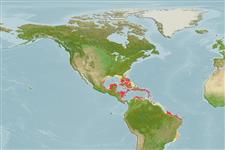Holothuroidea |
Holothuriida |
Holothuriidae
Environment: milieu / climate zone / ระดับความลึก / distribution range
นิเวศวิทยา
; ระดับความลึก 0 - 54 m (อ้างอิง 83942). Tropical
Western Atlantic: Gulf of Mexico and the Caribbean.
Length at first maturity / ขนาด / Weight / Age
วัยเจริญพันธุ์: Lm ? range ? - ? cm Max length : 35.0 cm TL เพศผู้/กระเทย; (อ้างอิง 624)
A coastal and nocturnal species. Forages on algal turf, seagrass meadows, and in rubble or sand covered areas (Ref. 485). This is an epibenthic, subtidal species found in coral reefs, seagrass and rocky bottoms (Ref. 83942). Nocturnal. Forages on algal turf, seagrass meadows, and in rubble or sand covered areas (Ref. 485).
Life cycle and mating behavior
วัยเจริญพันธุ์ | การสืบพันธุ์ | การวางไข่ | Eggs | ความดกของไข่ | Larvae
Members of the class Holothuroidea are gonochoric and have only one gonad. Spawning and fertilization are both external and some exhibit brooding. Life cycle: Embryos develop into planktotrophic larvae (auricularia) then into doliolaria (barrel-shaped stage) which later metamorphose into juvenile sea cucumbers.
Hasbún, C.R. and A.J. Lawrence 2002 An annotated description of shallow water holothurians (Echinodermata: Holothuroidea) from Cayos Cochinos, Honduras. Revista de Biología Tropical 50(2):669-678. (อ้างอิง 624)
IUCN Red List Status
(อ้างอิง 130435: Version 2025-1)
CITES status (อ้างอิง 108899)
Not Evaluated
CMS (อ้างอิง 116361)
Not Evaluated
Threat to humans
Human uses
| FishSource |
เครื่องมือ
ข้อมูลเพิ่มเติม
นิเวศวิทยาเขตร้อนFood items (preys)
องค์ประอบของอาหาร
การบริโภคอาหาร
ผู้ล่า
Population dynamicsการเจริญเติบโตMax. ages / sizesLength-weight rel.Length-length rel.Length-frequenciesMass conversionอุดมสมบรูณ์ Life cycleการสืบพันธุ์วัยเจริญพันธุ์ความดกของไข่การวางไข่EggsEgg developmentLarvae Human RelatedStamps, coins, misc.
แหล่งที่มาจากอินเตอร์เน็ต
Estimates based on models
Preferred temperature
(Ref.
115969): 24.9 - 28, mean 27 (based on 206 cells).
Fishing Vulnerability
Low vulnerability (25 of 100).
Price category
Unknown.
